Welcome to Special Collections
Welcome to Special Collections
Special Collections preserves and provides access to materials that are rare, fragile, and irreplaceable. It's home to the oldest, newest, rarest, weirdest, and most beautiful materials in Ellis Library.
Which is the oldest book in Special Collections?
Visitors often ask us about the oldest book in Special Collections, but it depends on how you define old - and how you define book. Browse these selections to see a few ideas on this subject.
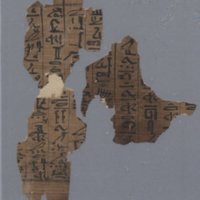
Fragment from the Egyptian Book of the Dead
Dating from approximately 1500-1100 B.C.E., this fragment from the Egyptian Book of the Dead isn’t the oldest item in Special Collections – but it is the oldest piece of writing on papyrus in Special Collections.
Papyrus is a plant that grows along the marshy banks of the Nile River, and the ancient Egyptians used it to make a paper-like substance for writing. Papyrus became one of Egypt’s main exports and was used throughout the ancient world, in Greece, modern-day Turkey, and the Middle East.
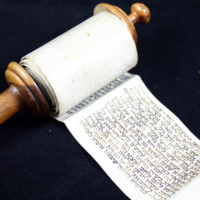
Hebrew Scroll of the Book of Ruth
If you guessed that the scroll represents the oldest book form in Special Collections, you would be right - however, this particular scroll isn't the oldest item in Special Collections.
The scroll predated the codex (the form we usually associate with a book nowadays) by thousands of years. In most of the Western world, the codex replaced the scroll gradually, from around 300 to 500 A.D. However, among Jewish communities, the scroll retained its place as the primary form for storing and transmitting information. Jewish congregations still use temple scrolls produced to strict specifications in their rituals of worship.
Although it’s old, this parchment scroll is far from ancient. It probably dates from the 1900s, contains the Book of Ruth, and may have been used in home worship.
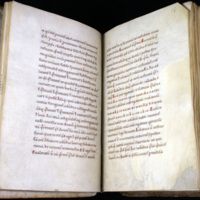
Latin Manuscript
This manuscript copy of De Constructione by Priscianus dates to around 1150 A.D. It was written entirely by hand on parchment, a smooth and durable writing material made from the skins of cows, sheep, goats, or other animals.
Although Special Collections holds manuscript fragments that are older, this is the oldest complete book in the collection. It is a work on grammar, written in Latin with passages in Greek.
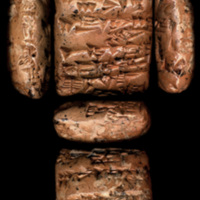
Cuneiform Tablet
You've found it! As far as we know, this cuneiform tablet dates to around 2500 B.C.E., making it the oldest item held in Special Collections (it predates the next oldest item, an Egyptian scarab seal, by about 500 years).
This tablet is one of eight held in the Special Collections department. It has text with information about the supplies a messenger would have needed to journey from one place to another.
What's new in Special Collections?
We are actively collecting materials from the entire timespan of history and around the globe, with an emphasis on adding underrepresented voices and supporting the Mizzou curriculum. Materials come into the collection through purchase, donation, or transfer from other parts of the library. Here are just a few of our newest acquisitions.
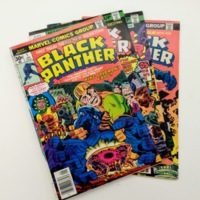
Black Panther
Comic books are an important source for studying popular culture and social history. We recently acquired a complete run of the Jack Kirby Black Panther series (1977-1979) for a course on global African literatures.

Hiller Collection of Audiovisual Materials on China
The Hiller Collection was donated to Special Collections by the Hiller family in 2018. The collection contains over 1,900 glass and acetate slides, several reels of 16mm film, four reels of 8mm film, and magnetic audio tape created by Army Air Corps Capt. Martin Hiller while stationed with his family in Shanghai, China. These rare color photos document cities, industries, farming, and everyday life in China during the second phase of the Chinese Civil War, 1945-1948. Special Collections and Digital Services are currently working to make the collection available online.
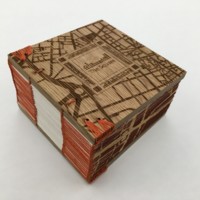
Artists' Books
Islam Aly
The Square, Al Midan
2014
Laser Cut, edge painting, laser etching
Book artist Islam Aly describes this work below:
"Egyptian uprising called for democratic reform. Tahrir Square in Cairo became the focal point and the most effective symbol of the protests in January and February 2011. For 18 days Egyptians repeated the slogan: The People Want to Bring down the Regime (al-sha`b yurid isqat al-nizam) until the regime stepped down on the 11th of February 2011. “This book focuses on the revolution slogan ‘al-sha`b yurid isqat al-nizam.’ Using Arabic Kufic script the words of the slogan are repeated in an ascending sequence. Section 19 contains the English translation for the slogan ‘The People Want to Bring down the Regime.’ The last section contains the time and date when the regime stepped down along with the sentence ‘Al Saa’b Askat al Nezam’ with its English translation ‘The People have Brought down the Regime’. “Cairo’s map is laser engraved on the book covers. Three edges of the book are colored then laser engraved to show the streets of Cairo."
This book was acquired along with several other artists' books in 2019. View more books like this one
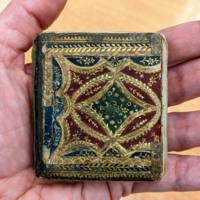
Commonplace Book
Hannah Marcy Ann Butcher
[A pocket book kept close and recording notes on etiquette, and poetry on women's virtue]
1790-1800?
Hannah Butcher used this little homemade book to record notes for her own reference. The book opens with the admonishment "Remember they Creator in the days of thy Youth," before moving into an etiquette ABC on "Rules for Good Manners." Much of this content is gendered in nature, though on the surface it appears ungendered. "A: Attend the advice of the old and the wise...D: Do the thing that you are bid...M: Make haste to obey, nor dispute nor delay...T: Transgress not the rules or at home or at school." The poetry and prose she quotes is similar in nature. Drawing from various hymns and poets like John Milton, she reflects on her duty to God and on her responsibility to obey those in authority (the implication being her father and her future husband). Yet we also discover that she has a love for learning and a desire to grow as a person--something important to the compiler of such an important and personal text. "May I my precious time employ so well It may rebound to my eternal joy Improve each talent with which I am blest And store up useful knowledge in my breast."
This book was acquired in 2019.
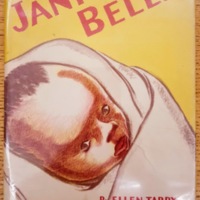
A Children's Literature Milestone
Ellen Tarry
Janie Belle, illustrated by Myrtle Sheldon.
New York : Garden City Publishing Co. Inc., [1940].
Janie Belle is a little baby nobody seems to want. The book narrates her small adventure from the time she was placed into a rubbish can until she was adopted by Nurse Moore.
This book is considered to be the first American picture book by an African-American author. It was acquired in 2019.
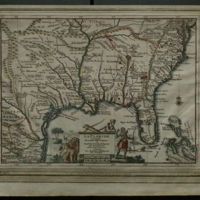
The Venable Map Collection
La Floride : suivant les nouvelles observations de Messrs. de l'Academie royale des sciences, etc.
A Leide : Chez Pierre vander Aa, 1713.
This map from 1713 shows the southeastern United States with names of indigenous tribes noted on their ancestral lands. It is part of the Venable Mp Collection, an important collection of early maps donated to the Libraries by Gary and Janet Venable in 2018.
What is the rarest book in Special Collections?
Many of the items in Special Collections are here because there just simply aren't very many of them in the world. While it's hard to say what the rarest item in the collection is, anything made by hand is considered to be unique - one of a kind - because even a direct copy can't completely replicate the original. Manuscripts, works of art, and scrapbooks are all examples of unique items.
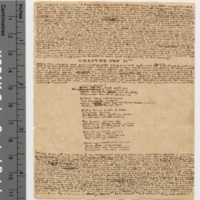
"The Secret" and "Lily Hart" by Charlotte Bronte
Charlotte Bronte, the author of Jane Eyre, wrote this tiny manuscript when she was seventeen years old. The manuscript contains two stories that center on the imaginary world created by the Bronte children: "The Secret" and "Lily Hart." The individual sheets are approximately 4 ½ inches long and 3 5/8 inches wide, and the entire text contains about nineteen thousand words. We're not sure why Charlotte and her siblings wrote these stories in such tiny script, but it's a characteristic of the Bronte juvenilia.
This manuscript has an interesting history - it was believed to be lost before it was donated to the Libraries in 1973. A reprint edition of the text is available for checkout from Ellis Library.
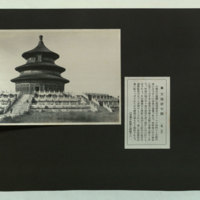
Japanese Photo Scrapbook
We know very little about this scrapbook, which was discovered during an inventory project in Special Collections. The photos appear to date from the early 20th century, and they show scenes in China, Korea, and Mongolia. Staff are currently working on identifying the photographs and translating the captions from Japanese into English.
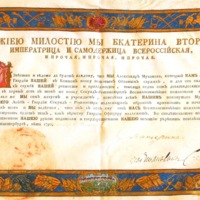
Promotion Charter Signed by Catherine the Great
Special Collections at Ellis Library possesses a charter signed by Catherine the Great, Empress of Russia. This document promotes Aleksandr Mukhanov, a young Russian nobleman, from regimental baggage-train driver to Lieutenant-Captain (Secund-Rotmistr) in the Horse-Mounted Guards.
This unique document was likely acquired sometime in the 1920s within a large and important collection of books and documents purchased for the University Library. It is printed on parchment with a hand-painted border of cobalt blue. There is a monogram of Catherine the Great at the center of the top border, surrounded by double-headed crowned birds, banners, firearms and cold steel, armor, and bows and quivers.
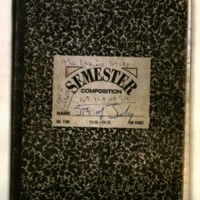
The Lanford Wilson Collection
Special Collections contains the papers of the Missouri-born, Pulitzer Prize-winning playwright Lanford Wilson. Wilson was a pioneer of Off-Off-Broadway theatre in New York in the 1960s. His work also featured gay characters early on, and his play, "The Hot l Baltimore," was adapted into a sitcom that included the first gay couple to be portrayed on a national television network.

The John Tinney McCutcheon Collection
John Tinney McCutcheon (1870-1949) is often referred to as “the Dean of Cartoonists” and is best known for his political and satirical work. McCutcheon’s cartoons provided commentary on presidential races, national politics, societal changes and economic hardships. He was particularly strong in his support for Theodore Roosevelt’s attempt at a third term as President and found in him an ample supply of material for his work in the Chicago Tribune.
Special Collections holds 368 original cartoons by McCutcheon. All of them have been digitized and are available in the University of Missouri Digital Library.
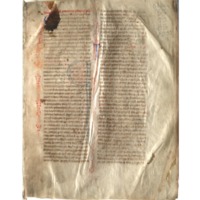
Medieval Manuscripts
Latin Bible.
Probably produced in Italy around 1300.
Gift of Dr. & Mrs. William F. Fratcher, 1983.
BS70 .B5 1300
Medieval manuscripts are not exactly rare - thousands of them survive in varying states of preservation. And this text, the Bible, survives in millions of copies, both manuscript and printed. However, each manuscript was produced entirely by hand, and even two texts by the same scribe would not be identical.
What is the weirdest thing in Special Collections?
Weird is in the eye of the beholder, so we asked the Special Collections staff to pick the items they think are the strangest.
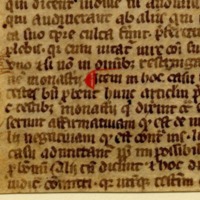
Medieval Doodles
Ever wonder what a 14th century curmudgeon would have looked like? Take a look at this fellow in the bottom left corner. He's a wonderfully weird addition to our Fragmenta Manuscripta Collection. With his twinkling one-eyed stare and perfectly shaped grimace - I mean lips, oops - you might just think there's a bee in his bonnet. But, of course, he's got something on his head, you say. Is it a bonnet? Or a hat? Who knows? More importantly, where's the bee? Well, there is no bee, don't you see? He's a curmudgeon who lives on a fragment that's all written in Latin and talks about witnesses and monasteries and building foundations and such. This fellow doesn't need a bee in his bonnet to be in a kerfuffle. He's just a wee marginal drawing on a bit of old parchment with a weirdly shaped hat on his oddly bald head.
-Nicole Songstad, Graduate Library Assistant, 2018-2019
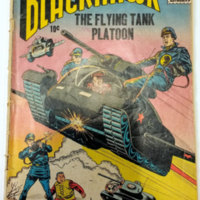
War Comics
Comics were popular culture long before being included in libraries. As such, comics reflect the history of the readers, writers, and the society which spawns them. This selection is partly propaganda against “the other” by distorting faces, and partly catering to a human desire to experience far-away action. The colors in particular create an aggressive and doomed look from the start.
-Courtney Gillie, Library Information Specialist
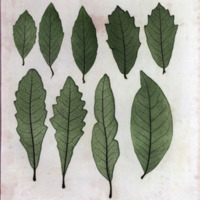
Nature Printing
This Austrian book, written by the director of the Austrian State Printing House, was the first to discuss the practice of “nature printing” which made it possible to make direct impressions of natural objects into lead and to therefore print images without engraving. The leaves in this image are therefore based directly on real leaves that grew in the 19th century.
-John Henry Adams, Reference and Instruction Librarian for Special Collections
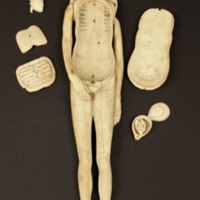
Ivory Anatomical Mannikin
Ivory manikins such as this one may have been used as educational tools by male doctors. It’s not clear who was the intended audience for the objects. Were they used to demonstrate basic anatomy to medical students? Or laypeople? Or were they simply luxury objects, curiosities to be kept in a doctor’s study?
Most of the ivory anatomical manikins still extant today are pregnant females. The artist of this figure even connected the fetus to the womb with a small piece of thread to represent the umbilical cord.
This particular example dates to the 1700s and is thought to be from Germany.
- Kelli Hansen, Head of Special Collections
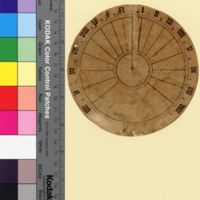
Volvelle
This little disc of paper is called a “volvelle” and it used to live inside a book somewhere but has since gone its own way. Volvelles are mobile parts of a book apart from pages: today, we mainly use them in pop-up books. This volvelle may have been a portable sundial at some point, though without the book it came from, we may never know!
-John Henry Adams, Reference and Instruction Librarian for Special Collectons
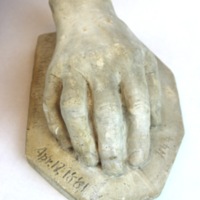
Plaster Cast of Walt Whitman's Hand
We're not exactly sure how, when, or why the Libraries got this plaster cast of Walt Whitman's hand. It was discovered during an inventory project in a metal box that was simply labeled "Walt Whitman's hand." Would you have opened the box?
More photos of Walt Whitman's hand
- Kelli Hansen, Head of Special Collections
What's the most beautiful thing in Special Collections?
Many of the things in Special Collections are beautiful, and for many different reasons. See below for our staff picks.

William Blake Facsimiles
William Blake was rather notorious for seeing visions and sharing them with the world through his writings and engravings. This selection is from America, A Prophecy, where Blake imagines the many forces shaping the Americas as personified. An insightful and grotesque examination is what yields such images.
-Courtney Gillie, Library Information Specialist
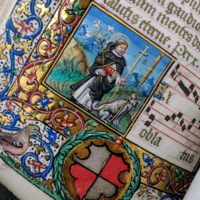
Sixteenth-Century Illuminated Manuscript
This processional manuscript was made for a sister of the Dominican Convent of St Louis in Poissy in the early 1500s. It has lavish borders illuminated with gold and precious pigments, musical notation framed by curling vines and tiny marginal creatures, and miniature paintings depicting saints (the one you're looking at is about the size of a large postage stamp!).
The binding is a beautiful example of the Parisian bookbinder Le Gascon’s later work. Active between 1620 and 1653, he used red morocco almost exclusively for his bindings and had all his ornamental tools for the gilding cut in dotted instead of solid outline. He worked for Gaston, Duc d’Orleans, Pierre and Jacques Dupay (perhaps the greatest French collectors of their day) and most probably, the Royal Library of France.
This book was purchased by a donor in 2016 to celebrate Ellis Library's one hundredth anniversary.
-Kelli Hansen, Head of Special Collections
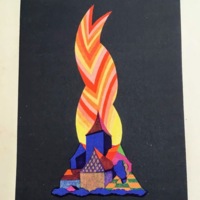
Die Reklame
Die Reklame was the trade publication of an early 20th-century German federation of advertisers. Particularly in the beginning, the monthly magazine was a veritable cornucopia of beautiful illustrations as printers included samples of their art to show what their technicians could do, whether it be in terms of color lithography or printing on foil wrappers.
-John Henry Adams, Reference and Instruction Librarian for Special Collections

Artwork
The image comes from a collection of English-French-Spanish prose, paired with paintings depicting the Spanish Revolution of 1936. The stylistic approach manages to convey emotions with image. Yes, this is just an old truck. It is also a celebration of life after war.
-Courtney Gillie, Library Information Specialist
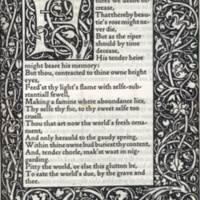
Kelmscott Press
William Morris was an artist and medievalist who is chiefly remembered today for the Kelmscott Press, the fine press that he established in the late 1800s. Morris insisted on only the finest materials and his work is recognizable both by the distinctive typefaces he designed and the intricate woodcuts he used to decorate the margins of his books. Morris believed that books should be beautiful as well as functional and this book is certainly that.
-John Henry Adams, Reference and Instruction Librarian for Special Collections
More About Special Collections
Materials in Special Collections total over 100,000 items. The collections are diverse and range from a substantial rare book collection with material dating to the eighth century to the comic arts collection, focused on underground comics, classic comic strips, and graphic novels. The collections include books, periodicals, manuscripts, maps, posters, printed ephemera, and artifacts.
This exhibit is a part of the University Libraries Online Scavenger Hunt. Whether or not you're a scavenger hunter, use this exhibit to explore just a few of the items in these amazing collections.
You're welcome to use the collections!
Appointments require 72 hours' notice.